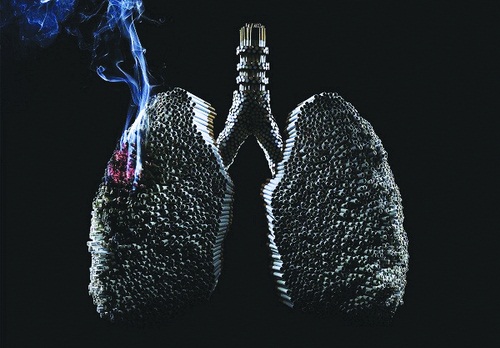Toxic substances hidden in cigarette smoke
Tobacco smoke contains 7,000 chemicals, including hundreds of substances that cause harmful effects on health.
According to a report by the American Medical Association, in cigarette smoke there are 69 substances that cause cancer. Some typical harmful substances in cigarette smoke include:
Nicotine
Nicotine is an addictive substance found in cigarettes. According to the literature, nicotine is absorbed into the bloodstream and affects the brain within about 10 seconds of being inhaled. When the nicotine in cigarette smoke binds to nicotine receptors on nerve cells at the "reward center" in the limbic system, neurotransmitters are released that trigger a series of chemical reactions that create produces many neuropsychiatric effects such as feelings of euphoria, joy, increased cognitive activity. However, that feeling will pass after a few minutes. When nicotine levels in the body decrease, smokers will feel restless and stressed; unable to concentrate; sadness, anxiety; sleep disturbance... Therefore, for comfort, the smoker has to smoke his next cigarette and create a spiral in the smoking. Nicotine, When it enters the bloodstream, it increases heart rate and blood pressure by stimulating the release of hormones such as adrenaline and narrowing blood vessels. Adrenalin increases heart rate, increases blood pressure and reduces blood circulation. In addition, when nicotine enters the bloodstream, it prevents the release of insulin from the pancreas. This hormone is responsible for removing excess sugar in the blood. As a result, smokers experience higher-than-normal blood sugar levels. Nicotine also has the same mechanism of affecting the brain as some other addictive substances such as cocaine and amphetamine, although to a lesser extent. In tobacco users, nicotine is found in all organs and in breast milk. For people who smoke more than 15 cigarettes a day, nicotine levels in the blood are consistently high, making quitting much more difficult. Adrenalin increases heart rate, increases blood pressure and reduces blood circulation. In addition, when nicotine enters the bloodstream, it prevents the release of insulin from the pancreas. This hormone is responsible for removing excess sugar in the blood. As a result, smokers experience higher-than-normal blood sugar levels. Nicotine also has the same mechanism of affecting the brain as some other addictive substances such as cocaine and amphetamine, although to a lesser extent. In tobacco users, nicotine is found in all organs and in breast milk. For people who smoke more than 15 cigarettes a day, nicotine levels in the blood are consistently high, making quitting much more difficult. Adrenalin increases heart rate, increases blood pressure and reduces blood circulation. In addition, when nicotine enters the bloodstream, it prevents the release of insulin from the pancreas. This hormone is responsible for removing excess sugar in the blood. As a result, smokers experience higher-than-normal blood sugar levels. Nicotine also has the same mechanism of affecting the brain as some other addictive substances such as cocaine and amphetamine, although to a lesser extent. In tobacco users, nicotine is found in all organs and in breast milk. For people who smoke more than 15 cigarettes a day, nicotine levels in the blood are consistently high, making quitting much more difficult. As a result, smokers experience higher-than-normal blood sugar levels. Nicotine also has the same mechanism of affecting the brain as some other addictive substances such as cocaine and amphetamine, although to a lesser extent. In tobacco users, nicotine is found in all organs and in breast milk. For people who smoke more than 15 cigarettes a day, nicotine levels in the blood are consistently high, making quitting much more difficult. As a result, smokers experience higher-than-normal blood sugar levels. Nicotine also has the same mechanism of affecting the brain as some other addictive substances such as cocaine and amphetamine, although to a lesser extent. In tobacco users, nicotine is found in all organs and in breast milk. For people who smoke more than 15 cigarettes a day, nicotine levels in the blood are consistently high, making quitting much more difficult.
Studies have also shown that tobacco manufacturers use many chemicals to increase the absorption of nicotine into the body.
Some typical toxic substances in cigarette smoke.
Tar (Tar)
Tobacco tar is a collection of thousands of chemicals and additives that are formed as a deposit of tobacco smoke that is sticky and thick. Tobacco tar is one of the most dangerous by-products of tobacco smoke, containing a lot of carcinogens.
When cigarette smoke is inhaled into the lungs, resinous substances are deposited and adhered to the air chambers of the lungs. After a while, the places where cigarette tar adhere to form cancer and lung diseases.
Carbon monoxide (CO gas)
The CO gas in cigarette smoke is absorbed into the blood and binds to hemoglobin, reducing the ability of red blood cells to carry oxygen, thus reducing the amount of oxygen in the blood, contributing to the formation of atherosclerotic plaques and affecting growth. and regulate the body, linked to heart disease, stroke, and other circulatory problems.
Benzene
A carcinogen found in petroleum fumes or in pesticides. This substance is found in very high concentrations in cigarette smoke, the amount of benzene that affects humans from tobacco smoke accounts for half of the benzene that enters humans from all sources.
When cigarette smoke is inhaled into the lungs, plastic substances are deposited and adhered to the air spaces of the lungs causing cancer and lung diseases.
Nitrosamines
A very potent carcinogen found in smokeless tobacco, snuff and tobacco smoke.
Ammonia
As a substance used in growth stimulants and in cleaning products. In tobacco manufacturing, this substance is used to enhance the addictive effects of nicotine.
Formaldehyde
Solution used in embalming. This substance irritates the nose, throat and eyes of smokers when breathing in cigarette smoke.
Hydrogen cyanide
An industrial pollutant, once used as a punitive substance in the United States.
Polycyclic aromatic hydrocarbons (PAH)
A carcinogen found in diesel and other combustion products.
Nhận xét
Đăng nhận xét